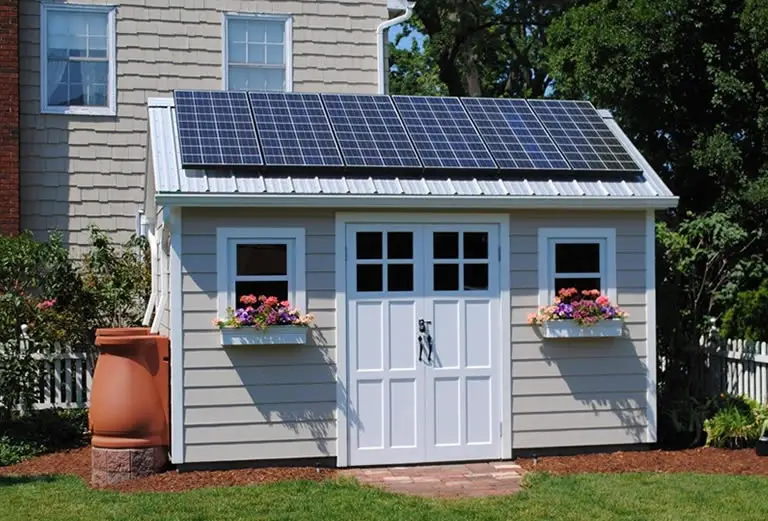You’re the proud owner of a shed man cave or she shed. By day, you love spending time in there, but by night, you’re back in your home since your shed doesn’t get any power or light. Your shed is too far from the house to run a cable, which is why you were thinking of using solar power and solar panels instead. How much solar power do you need for your shed?
The amount of solar power required for a shed depends on what you’re using it for. For example, it takes 600 watts to use a computer, 10 watts for a smartphone or tablet, and 240 watts for four ceiling lights. You’d add up your shed requirements and then determine the necessary wattage from there.
You can easily get the appropriate size of shed solar panel kit once you know what your specific power needs are. So, ahead, we’ll discuss in more detail how to determine the amount of wattage needed for your shed’s solar panels, how to install solar panels, and what they cost. You’re not going to want to miss it!
Contents
How Much Solar Power Does A Shed Need?
There is no one-size-fits-all solution for how much solar power your shed needs. One such factor that determines the number of solar panels to install is the size of your shed. Smaller sheds will need less power than larger ones.
Then you have to decide what you’ll use your shed for by night. Do you want to get work done in peace and quiet? Maybe you want to sit and watch the movies that you never get to see when the kids fight over the remote.
Finally, is all your power going to come from the solar panels or do you have other sources of light and power as well?
Only when you answer these questions can you confidently calculate the number of solar panels your shed needs.
How much wattage do all your everyday essentials suck up? We touched on this in the intro, but let’s talk further about it now.
- Internet router – 10 watts upon startup, 10 watts to use
- Lamp – 60 watts upon startup, 60 watts to use
- Coffeemaker – 600 watts upon startup, 600 watts to use
- Four overhead lights – 2,200 watts upon startup, 1,500 watts to use
- Tablet or smartphone – 10 watts upon startup, 10 watts to use
- Printer – 400 watts upon startup, 400 watts to use
- Computer – 600 watts upon startup, 600 watts to use
It doesn’t hurt to separate the items in your shed by those that require occasional power versus those that need constant power. For example, when charging your smartphone, it needs power, but only until it’s fully charged. Your laptop can run for a while before you have to plug it in, yet a desktop computer can only work when connected to power.
So let’s say you wanted all the above items in your shed, possibly all on at once. Your solar panels would have to be capable of generating at least 3,880 watts of power to accommodate for the higher power needs upon startup.
Although it is unlikely you will require that type of power, you may find that a single solar panel, or even set of solar panels, is not enough to meet your energy requirements. Luckily, there are multiple different sizes of solar panel kits available to suit all energy needs. But even if you can’t a find a kit that offers the type of excess power you need, you can always purchase additional panels, or even standing solar panels, and hook them up to the same local network that is powering your shed.
How to Get Solar Power to a Shed
Now that you know how much solar power your shed requires, how do you get it? Many shed owners have had good luck with a solar kit. If you’ve never used a solar kit before, it can be a bit confusing making sense of the components, so let’s talk about them now.
You Need An Inverter
You know the basic premise of solar panels, right? The panels absorb the sunlight into direct current or DC power. An inverter then takes the DC power and makes it into alternating current or AC power so it’s usable by all your appliances and devices.
The inverter looks like a small box, but its duty is massively important.
Next You Need A Charge Controller
The charge controller prevents the batteries from being exhausted so your solar kit can continue collecting energy that your shed utilizes.
Then Comes The Batteries
It might seem strange for a solar panel to include batteries. After all, doesn’t the solar panel run off natural energy? Yes, but how are you supposed to get power on a cloudy day or in the winter if you use your shed then? Exactly. That’s why you need batteries.
Most solar kits require two 12-volt batteries, but that can vary from one kit to another.
Shed Solar Panels Are The Last Piece Of The Puzzle
The last part of a solar panel kit is the solar panels themselves. Each panel has photovoltaic cells that absorb sunlight. Then the sunlight goes to the inverter and becomes usable energy, as we explained.
Your solar panel kit might also include an AC outlet, which allows you to charge devices that use AC power. The kit could include a DC LED light as well, which is intended to conserve your solar panel batteries.
How Much Does Solar Power Cost for a Shed?
So how much will it cost to outfit your shed with solar power? That again depends on the extent of your solar requirements.
Small kits are typically in the range of $300 to $500.
A larger kit can cost $1,500 and up.
You can check out a range of solar power kits with this link solar power kits for sheds.
How to Install a Solar Kit in Your Shed
Your shed solar kit just arrived and you’re very excited to get it all set up. While installation instructions might vary depending on kit, here are some generalized steps to get you started.
Step 1: Mount the Panels
Whether you have to mount the solar panels to your shed roof depends on the number of panels you have as well as how much space is available on your roof. If you only have two or three panels, then you can attach them via Z-brackets to the roof.
What if your shed roof is small and you can’t fit all the solar panels up there? Ground-mounting is another option.
Step 2: Install the Controller
The rest of the installation shouldn’t be tough, as many solar panel kits for DIYers include pre-drilled holes so you can figure everything out quickly. You must put the controller where you can access it, but that doesn’t necessarily mean it has to be highly visible.
Step 3: Place the Inverter
The location of your inverter must be carefully selected. It needs to be close to the other components of your solar power system but away from trees, shrubs, greenery, and landscaping. The inverter gets hot when it’s operating, so it can be a hazard if it doesn’t have enough room.
Step 4: Connect the Wiring
This is the most complex part, as you need to wire the solar kit together. The solar panels must be attached to the regulator via wires, then the controller to the battery and the battery to the inverter.
Step 5: Test the Solar Kit
If you did everything correctly, your solar kit should be operational. We recommend installing all the components during the day so a.) you can see what you’re doing and b.) your solar panels can begin using sun energy immediately.
The Benefits of Solar Panels for Sheds
Although it takes a lot of work to get your shed’s solar panel kit up and running, the results are more than worth it. Here are some perks you’ll get to enjoy.
Endless Renewable Energy
Most of the resources we use today are nonrenewable, which means that when they’re gone, they’re gone. Fortunately, solar power is not one of them. As a renewable energy source that comes from sunlight, you’ll have power to your shed that’s infinitely recyclable.
This is so much better for our planet. Nonrenewable resources tend to produce more carbon dioxide, which can increase the rate of greenhouse gases that accelerates global warming. Each time you use solar energy for your shed, you’re doing your part to keep our earth alive.
Lower Electric Bills
Here’s a benefit you’ll be sure to appreciate. If you were able to wire electricity to your shed, that could add hundreds of dollars to your monthly electric bills depending on how often you’re in there. Ouch!
A shed that uses renewable energy will never increase your energy bills. Plus, after your successful introduction to solar energy, you might decide to get solar panels for your home, which will lead to further savings!
Potential Tax Incentives
Cities and towns across the country offer tax incentives, rebates, and more to motivate homeowners to use solar energy. Look up the incentives in your neighborhood. You just might be able to get money back for using solar power.
You Can Heat Your Shed Cheaply With Solar Power
You’re one of those people who continues to spend time in your shed even in the autumn and winter. If you have a portable heater in the shed, can you use solar energy to power up the heater?
Indeed, you can! As we talked about earlier, a portable electric heater requires about 2,200 watts of energy to start up and then runs on 1,500 watts or so. If your shed needs two heaters, then multiply those numbers by two. Your solar panels should be able to generate at least that much electricity.
Remember not to put too much strain on your solar panel system!
Conclusion
Good solar power kits are a viable solution for many shed owners who want power and electricity in their sheds all year long.
Now that you know how to get your own kit and how to install one, you too can begin enjoying life more in your shed!

